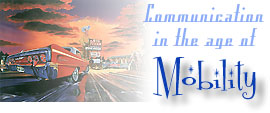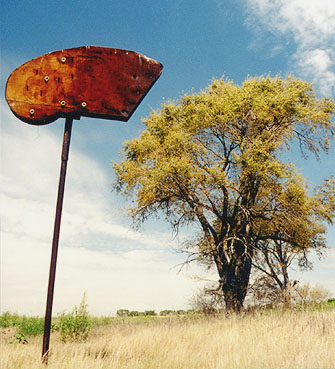
Office: HGH 210; phone: (408) 924-5378
Email: wooda@email.sjsu.edu
Web: http://www.sjsu.edu/faculty/wooda
 |
Dr. Andrew Wood Office: HGH 210; phone: (408) 924-5378 Email: wooda@email.sjsu.edu Web: http://www.sjsu.edu/faculty/wooda |
Introduction
: Course Calendar : Policies
: Readings
Assignments : Check Your Grades : Return
to Frontpage
Reading: Jackson, J.B. (1980). The necessity for ruins and other topics. Amherst: University of Massachusetts Press.
 In
his chapter, "The Necessity for Ruins" (pp. 89-102) from his book of the same
name, J.B. Jackson explores the changing American experience with monuments,
contributing to the notion that the age of mobility has diminished the role
of history in these public places of learning. This chapter is old - itself
a monument to a respected essayist on the cultural landscape and pioneer researcher
into "cultural geography" - but it makes a compelling point, that Americans
no longer create monuments to record specific historical moments or figures.
Rather, Americans celebrate "a private vernacular past - what we cherish are
mementos of a bygone daily existence without a definite date" (p. 89). Supporting
his claim, Jackson differentiates between hortatory monuments and what we might
call ahistorical monuments.
In
his chapter, "The Necessity for Ruins" (pp. 89-102) from his book of the same
name, J.B. Jackson explores the changing American experience with monuments,
contributing to the notion that the age of mobility has diminished the role
of history in these public places of learning. This chapter is old - itself
a monument to a respected essayist on the cultural landscape and pioneer researcher
into "cultural geography" - but it makes a compelling point, that Americans
no longer create monuments to record specific historical moments or figures.
Rather, Americans celebrate "a private vernacular past - what we cherish are
mementos of a bygone daily existence without a definite date" (p. 89). Supporting
his claim, Jackson differentiates between hortatory monuments and what we might
call ahistorical monuments.
The traditional hortatory monument seeks to relate the present to the past in order to give instruction on how we should live today and tomorrow: "Just as it confers a kind of immortality on the dead, it determines our actions in the years to come" (p. 93). In contrast, ahistorical monuments are typically generic; they commemorate anonymous persons without specific historic context. In part, this movement toward ahistorical monuments may be said to celebrate the "common man" as a symbol of democracy. However, Jackson proposes that the ahistorical monument locates itself in the realm of contemporary needs without regard for the past. It recalls not a specific person or time, but a feeling and nostalgia for innocence and simplicity. This recollection typically begins after a period of neglect, distant enough in time that its restoration is safely disconnected from an historical timeline. To Jackson, the necessity for ruins - the abandoned house, the decayed storefront, the relic motel - is their ability to provide props for the theater of reconstruction, figments of a narrative that may be reconstituted toward the needs and pleasures of the present, without the baggage of the past.
Is this movement toward the construction of ahistorical monuments indeed an aspect of the age of mobility? Jackson leaves this question to historians. However, it is worth noting that he dates the rough origin of ahistorical monuments in the mid-nineteenth century: "Even as Lincoln was speaking, a new philosophy of history and the meaning of history was taking form among Americans" (p. 93). In class, we shall encounter the relationship between the rise of steam transportation and the diminishing of American ties to time and space, epitomized by ahistorical monuments.
Activity
View the 1985 film, Back to the Future with some friends. Keep track of the differences between Hill Valley of the "present day" and the town of 1955. For your Show and Tell activity, identify three specific differences in the town and evaluate whether the film attempts to create a nostalgia for the past Hill Valley as a hortatory or an ahistorical monument.